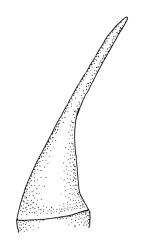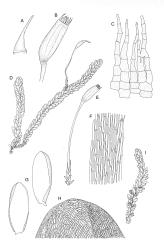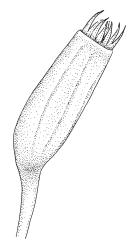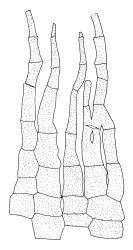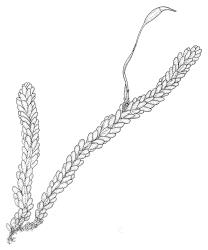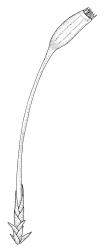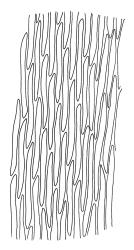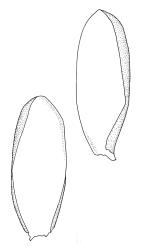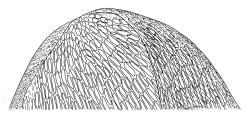- ≡ Leucodon nitidus Hook.f. & Wilson in Wilson, Bot. Antarct. Voy. II (Fl. Nov.-Zel.) Part II, 99 (1854)
Plants soft, yellow-green, strongly lustrous, forming interwoven mats on bark. Stems creeping, irregularly branched, mostly pale brown, to at least 35 mm long, in cross-section oval, with 2 layers of thick-walled cortical cells surrounding a parenchymatous core and lacking a central strand, with rhizoids sparse, restricted to branch bases, smooth, and red-brown. Branches scarcely differing from stems. Shoots slightly flattened, c. 1.5–1.8 mm wide. Leaves loosely imbricate and erect-spreading when dry, little altered when moist, becoming more tightly imbricate at shoot apices, erect, weakly ranked, and slightly complanate, symmetric, elliptic and broadly rounded, strongly concave and cucullate at apex, smooth both dry and moist, plane at margins, not decurrent, entire, c. 0.9–1.1(–1.2) × (0.25–)0.3–0.35 mm; mid and upper laminal cells vermicular, firm-walled (walls roughly equal to the lumina in width), weakly projecting at upper ends, not porose, mostly 42–51 × 3–4 µm, scarcely differentiated below but with a band of shorter and pigmented cells at insertion; alar cells irregular, thick-walled and pale brown, forming a very small group of c. 6–8 cells. Costa lacking. Paraphyllia lacking. Gemmae nil. Axillary hairs conspicuous, 3–4 celled, cylindric.
Dioicous. Perichaetia scattered on stem and branches, c. 1.5–1.8 mm long, the outer leaves squarrose, the inner leaves longer, tubular, and strongly sheathing the seta base, rounded or broadly obtuse at apex. Male plants not dwarfed; perigonia scattered, axillary and gemmiform, with few antheridia and no paraphyses. Seta 4–8 mm, straight, slightly sinistrorse, pale brown; capsules oblong-cylindric, erect or nearly so, weakly curved, with a weakly defined neck, strongly 8-ribbed, 1.5–1.8 mm, red-brown; exothecial cells short and weakly polygonal, not thickened at corners; in alternate bands of ± thin and thicker-walled cells; stomata superficial, restricted to extreme capsule base; annulus lacking; operculum rostrate from a conic base, c. ⅔ the urn length. Exostome absent; endostome yellow-brown or orange, inserted very close to rim, extending c. 270–360 µm beyond rim, arising from a basal membrane 3–4 cells and c. 75–100 µm high; segments 16, undivided or forked nearly to base (with one half sometimes irregularly subdivided), with a median longitudinal line on both surfaces, not keeled, ± smooth or finely papillose. Calyptra cucullate, smooth, covering operculum and c. upper half of capsule. Spores single-celled, c. 18–33 µm, yellow-brown in mass, coarsely papillose, occasionally germinating in capsule.
Wilson 1854, pl. 87, fig. 4 (as Leucodon nitidus); Magill 1987, figs. 1–6, 9; Malcolm & Malcolm 2003, p. 21.
Dichelodontium nitidum is most likely to be confused with Orthorrhynchium elegans, but the present species has only weakly complanate shoots, while those of O. elegans are strongly complanate and the leaves virtually distichous. The leaves of Dichelodontium are strongly concave and cucullate, whereas those of O. elegans are conduplicate. The sporophytes also differ markedly. Confusion with Fallaciella gracilis is also possible, but the latter species is nearly always terrestrial, is less glossy, and has more distinctly acute leaves, as well as alar cell and sporophytic differences.
NI: N Auckland (Waipoua Forest, Hunua Range), S Auckland (numerous localities), Gisborne (numerous localities, including Waikaremoana area), Hawke’s Bay (near Tūtira, Titiokura Hill, near Wairoa, near Mōrere), Taranaki (numerous localities), Wellington (numerous localities); SI: Nelson (Collingwood, Charleston, Punakāiki area), Marlborough (Endeavour Inlet, Pelorus Sound), Westland (numerous localities), Otago (near Dunedin, Papatōwai), Southland (numerous localities).
Endemic.
This species occurs most frequently in moister parts of N.Z. Accordingly it is only sparsely recorded from Hawke’s Bay, Nelson, and Marlborough L.D. and it is unrecorded from Canterbury and the drier portions of Otago L.D. Dichelodontium nitidum occurs on trunks of a wide variety (at least 16 genera) of mostly smooth-barked tree species. Associated bryophyte species include Calyptopogon mnioides, Leptodon smithii, Macromitrium spp., Orthorrhynchium elegans, Tetraphidopsis pusilla, and Zygodon hookeri, as well as Frullania spp., Porella elegantula, and Metzgeria hamata. Ranging to c. 915 m (Mt Taranaki) on the North I. and from near sea level (near Punakāiki) to at least 380 m (Kelly’s Creek, Westland L.D.) on the South I.
Unlike in some genera of the Ptychomniaceae, the primary and secondary stems cannot be differentiated here. The highly lustrous and slightly compressed shoots with elliptic, strongly concave, and apically cucullate leaves are distinctive. The apical leaves are more erect and imbricate than those below, causing the stems/branches to terminate in a compact cluster of leaves, which lends distinction to this species. In some, but not all, collections the terminal leaf cluster is weakly flattened. The erect and ribbed capsules with long-beaked opercula, if present, likewise facilitate recognition of D. nitidum in the field. The gametophytic features appear very constant, while some sporophytic characters (including peristome and spore dimensions) vary considerably. Sainsbury’s (1955) description indicated a wider range of spore size than that described above.



